|
Canoe Fire Case Study
Humboldt Redwoods State Park
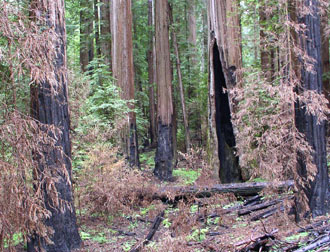 The Canoe Fire burned over 11,000 acres of old growth and second growth coast redwood forest in Humboldt Redwoods State Park in late 2003 (Scanlon 2007). It is the most significant fire to have burned in coast redwood during the last half century because of its extent and the diversity of vegetation types that were burned. The Canoe Fire burned over 11,000 acres of old growth and second growth coast redwood forest in Humboldt Redwoods State Park in late 2003 (Scanlon 2007). It is the most significant fire to have burned in coast redwood during the last half century because of its extent and the diversity of vegetation types that were burned.
Included in the wildfire were old growth and second growth redwood forests on alluvial terraces of the South Fork of the Eel River and Canoe Creek, upstream riparian areas, mixed-evergreen slopes of all aspects and logging histories, former prairies invaded by Douglas fir, and prairies dominated by invasive grasses. The 2008 Orr Fire in Montgomery Woods State Reserve followed a similar pattern, but the publicly held area that burned there was much less.
From an historical perspective, the Canoe fire is also significant because it was the first major fire to burn in a coast redwood reserve since large-scale acquisition and fire suppression efforts began in the 1930s. Because it was ignited by lightning, it tested our assumptions about the risks of wildfire in the northern reaches of this vegetation type.
The Fire Event
The lightning storm that started the Canoe fire on September 3, 2003 ignited at least 273 other fires from San Francisco Bay to the Oregon border. The ignition site was hard to access because it was in a remote, rugged part of a Wilderness Area. What's more, fire agencies had so many other fires to deal with, the Canoe Fire had time to spread to where immediate suppression was not feasible. Containment lines were eventually drawn to approximate the watershed boundary of Canoe Creek and the South Fork of the Eel River on the east side. The fire burned until the first week of October and exceeded 10,000 acres.
Using the Palmer Drought Severity Index (PSDI) as a measure, the climate conditions in northwestern California were dryer than normal when the fire began and through September (below).
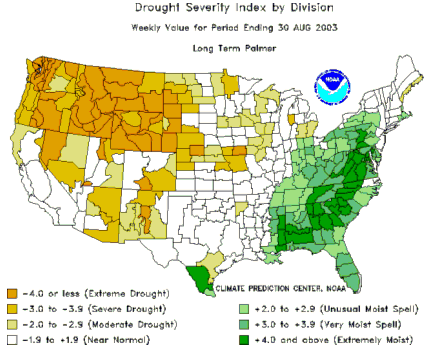
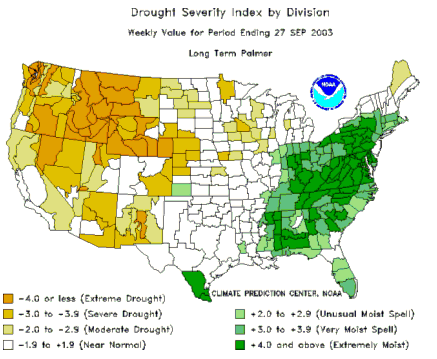
Daily fire weather conditions showed variation that is typical of this time of the year. Note the day-to-day variability in peak temperatures and minimum relative humidities over the course of the burn. This variation in burning conditions affected the way fire behaved as it progressed through the watershed.
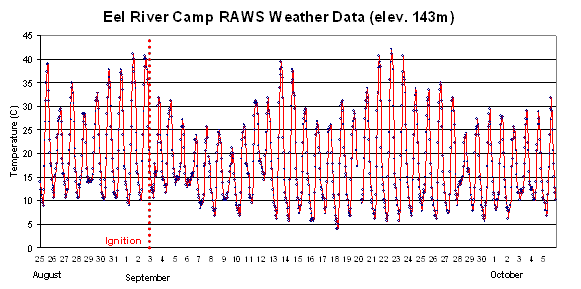
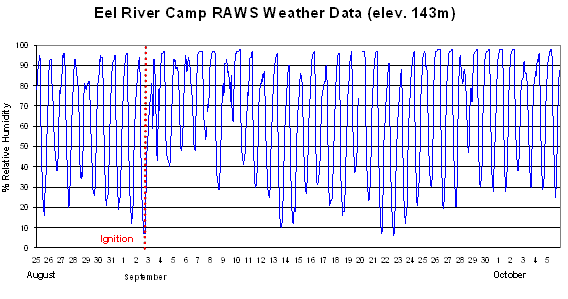
As is common across the mountainous portions of northwestern California, nocturnal inversions take a while to lift (below, left). Fire gradually spread across the watershed, burning upper slopes and riparian areas (below, right).
Flame lengths and fire behavior were usually short and mild. The remarkable images of fire behavior were taken along the fire lines by Stephen Underwood. The last two show Douglas fir burning out from below (bottom center) and on its bark (bottom right).
Fire Ecology
As is typical in the Klamath Mountains to the east, fire behavior varied not only with topography but according to fuel type and land use history. As these aerial photos reveal, upper slopes that were dominated by Douglas-fir burned hot, as did areas that had been logged in the last half century. One anomaly stands out though. A landslide on Canoe Creek that had many logs and debris at its base burned hot (below, top-center). The heat from this pocket of riparian fuel killed trees across the valley.
On the ground, these aerial effects of the fire were largely substantiated. Research by University of California Extension Forester Yana Valachovic confirmed the importance of logging history and topography on fire severity.
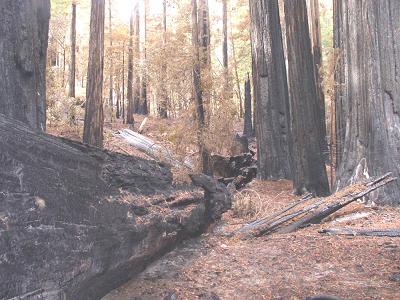 The surface fuels that burned on the alluvial terraces during the Canoe fire had been accumulating since the 1964 flood when up to a meter of sediment was deposited. No measurements were undertaken prior to the fire, but on comparable alluvial sites outside the fire perimeter, depth averaged 13 cm in 2004. These sites were close to achieving a net balance between litter fall and decay at the time of the fire, because it can take less than two decades for these rates to equilibrate (Pillars and Stuart 1993). One year after the fire, a continuous cover of litter within the burn area had reached a depth of 1-2 cm, although most came from needles that were scorched during the event and fell over the winter. The surface fuels that burned on the alluvial terraces during the Canoe fire had been accumulating since the 1964 flood when up to a meter of sediment was deposited. No measurements were undertaken prior to the fire, but on comparable alluvial sites outside the fire perimeter, depth averaged 13 cm in 2004. These sites were close to achieving a net balance between litter fall and decay at the time of the fire, because it can take less than two decades for these rates to equilibrate (Pillars and Stuart 1993). One year after the fire, a continuous cover of litter within the burn area had reached a depth of 1-2 cm, although most came from needles that were scorched during the event and fell over the winter.
Transformational fire effects--the ones we worry most about--may have less to do with litter and duff accumulation as they do with the larger woody fuels that accumulate at the bases of trees . These fuels are slow to decay and can continuously accumulate over decades or even centuries. The consumption of a large volume of coarse fuel at the base of a redwood tree can lead to broad scars that introduce decay to the sapwood and that require a decade or more to heal over. Invisible to the untrained eye until the deadened bark falls away, extensive scarring can permanently alter the mortality rate of trees over their lifetime.
During a fire, a redwood tree can lose all of its foliage from scorching heat, but it almost always resprouts epicormically within a few months or by the following year. The most damaging effects of fire are basal, as heat conducts horizontally through the bark from adjacent fuels, radiantly from nearby logs or adjacent trees and conductively, radiantly and convectively within basal cavities.
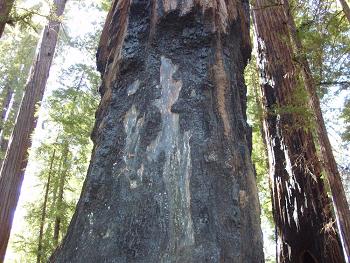 Redwood bark is notable in that it burns. Its general thickness has been dubbed an insolating adaptation to fire, but redwood bark is far less fire resistant than the tree's sound heartwood. In the Canoe fire, redwood bark was substantially thinned at most tree bases, and it readily smoldered for days after fire passed. The bark's fibrous nature works against it, as it readily catches sparks then smolders upward on individual bark ridges to create distinctive bark notches. Such notches are common across the coast redwood range, even after the charred outer surface erodes away. Occasionally, all of the bark is consumed by fire to expose the sapwood. Few trees can survive this partial girdling and when it occurs on multiple sides of the tree it will likely die (above). Because bark burnback relates so well to fire intensity and these key long-term effects (redwood scarring and mortality), it provides a practical indicator of how different wildfires' effects can be valued and compared. Redwood bark is notable in that it burns. Its general thickness has been dubbed an insolating adaptation to fire, but redwood bark is far less fire resistant than the tree's sound heartwood. In the Canoe fire, redwood bark was substantially thinned at most tree bases, and it readily smoldered for days after fire passed. The bark's fibrous nature works against it, as it readily catches sparks then smolders upward on individual bark ridges to create distinctive bark notches. Such notches are common across the coast redwood range, even after the charred outer surface erodes away. Occasionally, all of the bark is consumed by fire to expose the sapwood. Few trees can survive this partial girdling and when it occurs on multiple sides of the tree it will likely die (above). Because bark burnback relates so well to fire intensity and these key long-term effects (redwood scarring and mortality), it provides a practical indicator of how different wildfires' effects can be valued and compared.
The most important effect of fire and fire exclusion in coast redwood relates to the genesis and development of basal cavities. Broad scarring leads to sapwood decay, and analysis indicates that the extent of decay increases according to the number of years it takes for the scar to heal over. Frequent fire can reduce fuel and the extent of scars and decay; infrequent fire leads to more fuel, larger scars and more years to heal over. Under frequently occurring conditions, basal cavities are initiated by the burnout of decay concavities result in increased feedbacks of radiant heat which with repeated burning can reduce the wood available for support. This process leads to tree collapse during the fire event or during the subsequent winter windstorms. Around 1-3 percent of redwood fell during the Canoe fire; the great majority fell because their cavities were enlarged by the fire.
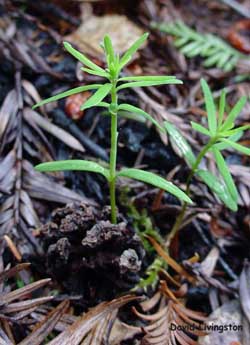 While the Canoe fire occasionally killed older redwood trees, it also initiated new growth in the form of sprouts from living and killed trees and from seed. Basal sprouts were ubiquitous and occurred most often on small and mid-sized trees that had experienced cambial or partial canopy decline. Upon close inspection, many sprouts generated from preexisting sprouts that were killed by the fire. For a number of reasons, the ability of coast redwood to sprout declines with tree age. This phenomenon suggests that forests dominated by large redwood may be less capable of regeneration through resprouting than are younger stands with pre-existing fire-initiated sprouts. Of interest, seeding is also at its maximum when redwoods are only a few hundred years old (Olson et al. 1990). While the Canoe fire occasionally killed older redwood trees, it also initiated new growth in the form of sprouts from living and killed trees and from seed. Basal sprouts were ubiquitous and occurred most often on small and mid-sized trees that had experienced cambial or partial canopy decline. Upon close inspection, many sprouts generated from preexisting sprouts that were killed by the fire. For a number of reasons, the ability of coast redwood to sprout declines with tree age. This phenomenon suggests that forests dominated by large redwood may be less capable of regeneration through resprouting than are younger stands with pre-existing fire-initiated sprouts. Of interest, seeding is also at its maximum when redwoods are only a few hundred years old (Olson et al. 1990).
The coast redwood seedling at left came from the cone at its base. The year after the fire, redwood seedlings were highly patchy, but they were frequently encountered in gaps of upland sites. By five years after the fire, only a small fraction had survived, and in contrast, Douglas fir seedlings remained abundant. This suggests that in the upland forests of Humboldt Redwoods State Park, coast redwood regeneration is strongly dominated by sprouting individuals, and in the absence of this adaptation, the importance of coast redwood would probably decline in the stand with episodic fire. Of note, while seeding redwood are known from elsewhere, such as under the meadow- encroaching Douglas fir canopies of Redwood National Park, the relative importance of fire, climate and competition have yet to be understood within the context of the species' range.
Fire History
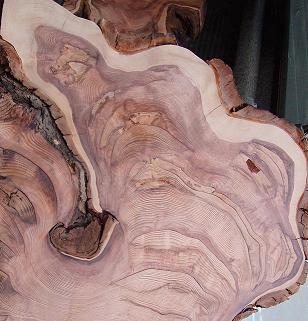 Following the Canoe fire, partial cross sections were removed from trees that were felled during the event to better understand how fire occurred in the past. Among the more interesting discoveries was that the alluvial terraces burned surprisingly often and with similar frequencies to dryer upland sites. Such high fire frequencies in riparian areas had not been appreciated. Following the Canoe fire, partial cross sections were removed from trees that were felled during the event to better understand how fire occurred in the past. Among the more interesting discoveries was that the alluvial terraces burned surprisingly often and with similar frequencies to dryer upland sites. Such high fire frequencies in riparian areas had not been appreciated.
Between 1700 and 1850, when the native Sinkyone-Lolangkok inhabited the area, fire burned between 10 and 15 years, often several times per decade. Frequent fire continued through the late 1800s, after the arrival of Euro-Americans, until the 1930s when it was excluded from the landscape. Given the cultural value of fire to Natives and early European-Americans, most historical fires were likely started by people. The Canoe fire was ignited by lightning, however, and it suggests that the area probably experienced mixed ignitions in the past and that fire exclusion may not be an option in the dryer, inland coast redwood forest.
![Comtemplating an exploratory cut in a coast redwood killed by the Canoe fire. Rocco Fiori (left); Steve Norman (right) [Credit: Stephen Underwood, CDPR]](images/Canoe_samplingCC_sn-rf.jpg)
References Cited
Pillars, M.D. and J.D. Stuart. 1993. Leaf-litter accretion and decomposition in interior and coastal old-growth redwood stands. Can. J. For. Res. 23: 552-557.
Olson, D.F., Roy, D.F, Walters, G.A. 1990. Sequoia sempervirens (D.Don) Endl., redwood. In: Burns, R.M. Honkala, B.H. (Tech. Coords.) Silvics of North America. Vol. 1, Conifers. US Government Printing Office, Washington D.C. pp: 541-551.
Related Pages
Steve Norman
|
|







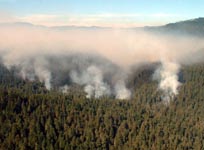
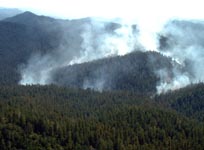
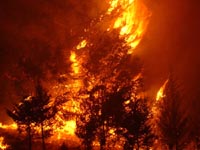
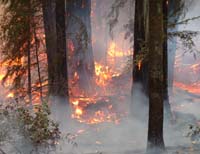
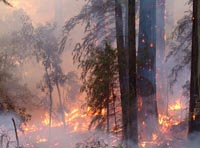
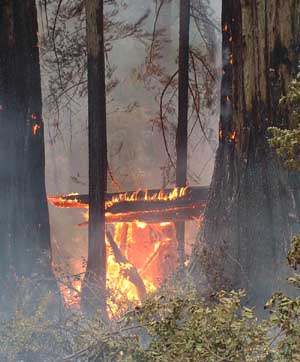
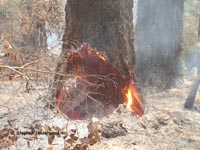
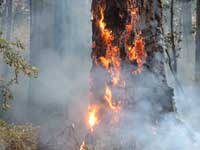
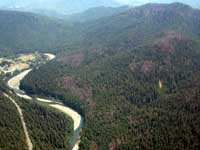
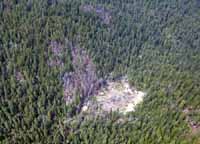
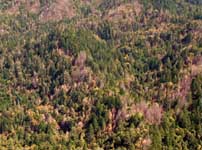
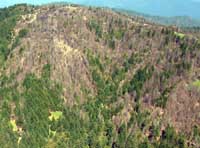
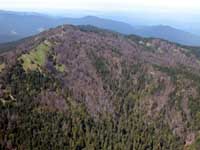
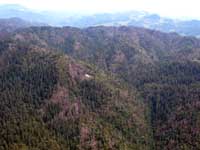
 The surface fuels that burned on the alluvial terraces during the Canoe fire had been accumulating since the 1964 flood when up to a meter of sediment was deposited. No measurements were undertaken prior to the fire, but on comparable alluvial sites outside the fire perimeter, depth averaged 13 cm in 2004. These sites were close to achieving a net balance between litter fall and decay at the time of the fire, because it can take less than two decades for these rates to equilibrate (
The surface fuels that burned on the alluvial terraces during the Canoe fire had been accumulating since the 1964 flood when up to a meter of sediment was deposited. No measurements were undertaken prior to the fire, but on comparable alluvial sites outside the fire perimeter, depth averaged 13 cm in 2004. These sites were close to achieving a net balance between litter fall and decay at the time of the fire, because it can take less than two decades for these rates to equilibrate ( Redwood bark is notable in that it burns. Its general thickness has been dubbed an insolating adaptation to fire, but redwood bark is far less fire resistant than the tree's sound heartwood. In the Canoe fire, redwood bark was substantially thinned at most tree bases, and it readily smoldered for days after fire passed. The bark's fibrous nature works against it, as it readily catches sparks then smolders upward on individual bark ridges to create distinctive bark notches. Such notches are common across the coast redwood range, even after the charred outer surface erodes away. Occasionally, all of the bark is consumed by fire to expose the sapwood. Few trees can survive this partial girdling and when it occurs on multiple sides of the tree it will likely die (above). Because bark burnback relates so well to fire intensity and these key long-term effects (redwood scarring and mortality), it provides a practical indicator of how different wildfires' effects can be valued and compared.
Redwood bark is notable in that it burns. Its general thickness has been dubbed an insolating adaptation to fire, but redwood bark is far less fire resistant than the tree's sound heartwood. In the Canoe fire, redwood bark was substantially thinned at most tree bases, and it readily smoldered for days after fire passed. The bark's fibrous nature works against it, as it readily catches sparks then smolders upward on individual bark ridges to create distinctive bark notches. Such notches are common across the coast redwood range, even after the charred outer surface erodes away. Occasionally, all of the bark is consumed by fire to expose the sapwood. Few trees can survive this partial girdling and when it occurs on multiple sides of the tree it will likely die (above). Because bark burnback relates so well to fire intensity and these key long-term effects (redwood scarring and mortality), it provides a practical indicator of how different wildfires' effects can be valued and compared.  While the Canoe fire occasionally killed older redwood trees, it also initiated new growth in the form of sprouts from living and killed trees and from seed. Basal sprouts were ubiquitous and occurred most often on small and mid-sized trees that had experienced cambial or partial canopy decline. Upon close inspection, many sprouts generated from preexisting sprouts that were killed by the fire. For a number of reasons, the ability of coast redwood to sprout declines with tree age. This phenomenon suggests that forests dominated by large redwood may be less capable of regeneration through resprouting than are younger stands with pre-existing fire-initiated sprouts. Of interest, seeding is also at its maximum when redwoods are only a few hundred years old (
While the Canoe fire occasionally killed older redwood trees, it also initiated new growth in the form of sprouts from living and killed trees and from seed. Basal sprouts were ubiquitous and occurred most often on small and mid-sized trees that had experienced cambial or partial canopy decline. Upon close inspection, many sprouts generated from preexisting sprouts that were killed by the fire. For a number of reasons, the ability of coast redwood to sprout declines with tree age. This phenomenon suggests that forests dominated by large redwood may be less capable of regeneration through resprouting than are younger stands with pre-existing fire-initiated sprouts. Of interest, seeding is also at its maximum when redwoods are only a few hundred years old ( Following the Canoe fire, partial cross sections were removed from trees that were felled during the event to better understand how fire occurred in the past. Among the more interesting discoveries was that the alluvial terraces burned surprisingly often and with similar frequencies to dryer upland sites. Such high fire frequencies in riparian areas had not been appreciated.
Following the Canoe fire, partial cross sections were removed from trees that were felled during the event to better understand how fire occurred in the past. Among the more interesting discoveries was that the alluvial terraces burned surprisingly often and with similar frequencies to dryer upland sites. Such high fire frequencies in riparian areas had not been appreciated. ![Comtemplating an exploratory cut in a coast redwood killed by the Canoe fire. Rocco Fiori (left); Steve Norman (right) [Credit: Stephen Underwood, CDPR]](images/Canoe_samplingCC_sn-rf.jpg)